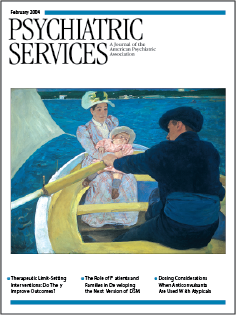Medication Adherence Among Psychotic Patients Before Admission to Inpatient Treatment
Abstract
OBJECTIVE: Nonadherence to antipsychotic regimens is considered to be one of the main reasons for hospital readmission. This study assessed the extent of nonadherence in the month before inpatient treatment. METHODS: Ninety-five consecutive patients with an ICD-10 diagnosis of a psychotic disorder (F20) were surveyed about adherence at admission to psychiatric inpatient treatment at a hospital in Linz, Austria. Adherence was assessed on the basis of self-report and by interviewing multiple informants. Episodes of inpatient treatment during the year after discharge were assessed prospectively. RESULTS: Fifty-four patients (57 percent) were rated as partially or fully nonadherent. Compared with patients with good adherence, those who were nonadherent had lower mean scores on the Global Assessment of Functioning (41.4 compared with 47.2), more often received compulsory treatment (52 percent compared with 22 percent), more often had impaired insight into their illness at admission (63 percent compared with 24 percent) and discharge (41 percent compared with 13 percent), and had more days of inpatient treatment in the year after discharge from the index episode (mean of 44.8 days compared with 20.6 days). Adherence was significantly better among patients in regular contact with their psychiatrist and among younger patients. Nonadherent patients who gained insight during treatment had significantly fewer days of inpatient treatment during the next year than those whose insight was still low at discharge (mean of 19.2 days compared with 73.2 days). CONCLUSIONS: Nonadherence is an important contributor to the need for inpatient treatment and is associated with a less favorable course of treatment. The best predictor of further inpatient treatment is insight into illness at discharge.



